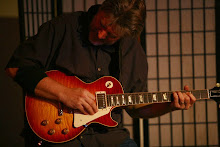zencat 12/20/2003 2:10 PM
Hi Don, This is a two part question: In your Melodic Minor Book, Unit 6: Using Melodic Minor Arpeggios, paragraph 3, you write: “There are many ways to use the arpeggios of the melodic minor scale. The trick to this is you need to be able to phrase the arpeggios in a way that still communicates to your listener the “sound” of D7…” That was a cliffhanger for me! From what I think you might have meant is that, we should use the notes contained in the melodic minor scale (not the primary chord tones, 1-3-5-7) as passing tones. Put in other words: to place the “altered” notes contained in the scale on the weaker metrical points, and emphasize the chord tones on the strong beats. Is this correct? Can you extrapolate further please? That brings me to question #2, regarding the approach of using chromatics and chromatic/melodic “shapes” to target essential chord tones: It seems to me that the chord scale approach is a lot more cumbersome than the targeting approach. If I keep the appropriate arpeggio in mind while soloing over a given chord, it makes it a lot easier for me to use the “target” approach instead of thinking, melodic minor, harmonic minor, diminished, wholetone, augmented scale, (just a few scale choices) and their modal derivatives. Don’t get me wrong, I love all those scales, and after a number of years of usage, I’m becoming more adept in their application and harmonic potential. They have definitely expanded my improv toolbox. But the other approach of targeting is really begging the question: “Why not take the simpler path?” Any comment on this? Sorry for the length of this post, and thank you for the opportunity to post it. All the best
Don Mock 2/16/2004 12:02 AM
Well Zencat, I now feel like an idiot that I did not respond right away to your great post about the melodic minor and targeting. I guess I thought I had read this one, but just spaced and missed it. No wonder you sent the "waste of time" post a few weeks later. Anyway, lets get to your questions. Any time a player uses any kind on superimposition ideas such as arpeggios and scales etc., the player should try to keep the sound of the chord a priority. It's easy when learning to do this to wonder into the tonality of the tool you are using rather than use the tool to sound the chord for you. Your response is right on the money. Keeping the chord tones emphasized. But this does not necessarily have to be related to strong or weak beats. It is a lot to do with the melodic phrasing too. You nailed the part about targeting. A very valid approach to improvising is to start with arpeggios first, before scales. And reach out to the "other" notes not in the arp. Joe Pass would agree with this. He was all about chord tones and melodies. "Screw the scales" said Joe on numerous occasions. In the big picture, all the paths end up at the same place. It's like the old GIT "West Coast" key center approach vs. the Berklee "East Coast" modal approach. Both get you the same end result. At GIT we told student at first to just play the C scale through a I-VI-II-V progression in C. Then add arpeggios for each chord next. At Berklee, you learn four complete scales-modes for the same progression. I think the key center path is physiologically faster cause it gets people playing faster. But in the end they still have to learn to sound each chord. Well enough of me rambling on. You hit on a lot of great points and I hope that a lot of player read what you said...should give them something to think about. So Zencat, come on back and add some more, it was great. - Don Mock
Subscribe to:
Post Comments (Atom)

My goodness; seven years later and I just now find your generous reply to my question! It was great reading your wisdom on my question. My ears, and knowledge, have grown somewhat since that post and your words are so in time for me to hear them better. Glad I read it; karma I suppose ;) You're a diamond among educators - and players! All the best.
ReplyDeleteEmanuel - aka zencat